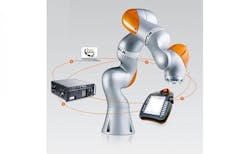Delicate Assembly Cobot
The LBR iiwa is the world’s first series-produced sensitive and HRC-compatible robot. LBR stands for “Leichtbauroboter” (German for lightweight robot), iiwa for “intelligent industrial work assistant”. This signals the beginning of a new era in industrial, sensitive robotics–and lays the foundations for innovative and sustainable production processes. For the first time, humans and robots can work together on highly sensitive tasks in close cooperation. This opens up the possibility of new applications and the way is paved for greater cost-effectiveness and utmost efficiency. The collaborative and sensitive LBR iiwa robot is available in two versions with payload capacities of 7 and 14 kg.
Thanks to its joint torque sensors, the LBR iiwa can detect contact immediately and reduces its level of force and speed instantly. Its position and compliance control enables it to handle delicate components without creating crushing and shearing hazards.
You can choose from three operating modes and program the LBR iiwa via simulation: indicate the desired position and it will remember the coordinates of the path point. Stop for breaks and control it with simple touch commands.
The lightweight LBR iiwa with its high-performance servo control is able to detect contours quickly under force control. It establishes the correct installation position and mounts components quickly and with the utmost precision with an axis-specific torque accuracy of ±2% of the maximum torque. The LBR iiwa can also find small, delicate components in next to no time without your assistance.
The LBR iiwa's controller, KUKA Sunrise Cabinet, simplifies the quick start-up of even complex applications. Give your operator a third hand and have the LBR iiwa take care of unergonomic, monotonous tasks reliably and independently.
The energy supply system for the external components is hidden in the kinematic structure of the LBR iiwa. Pneumatic and electrical energy supply systems are available. All media flanges have a hole pattern conforming to DIN ISO 9409-1-50-7-M6.
